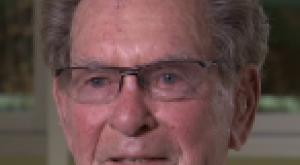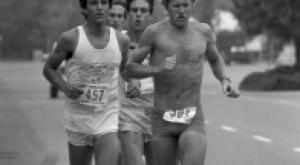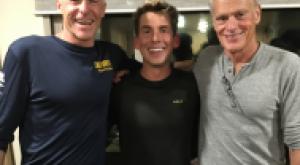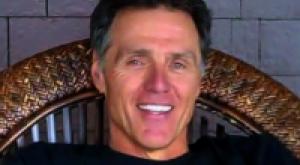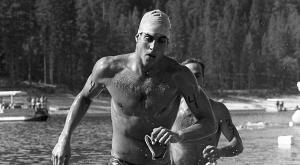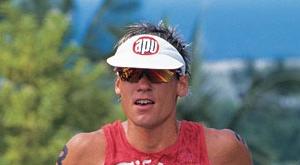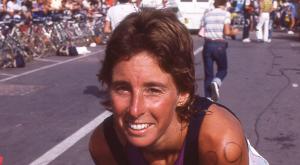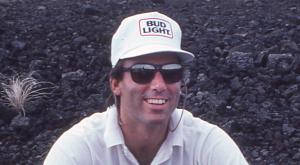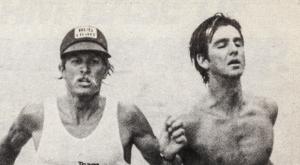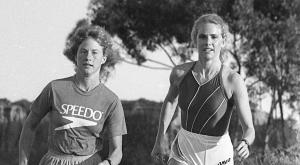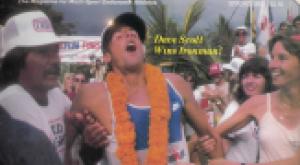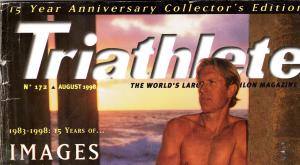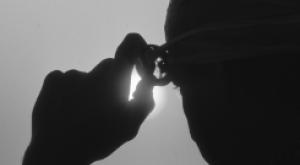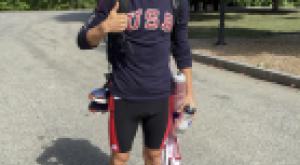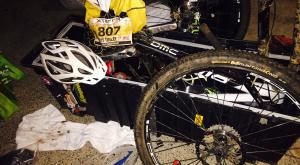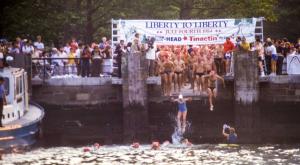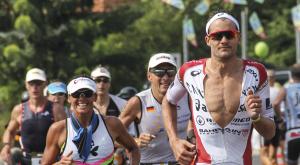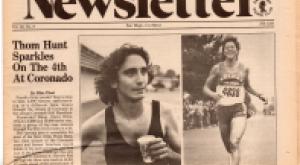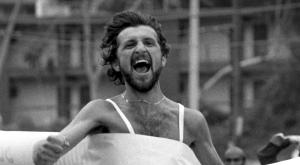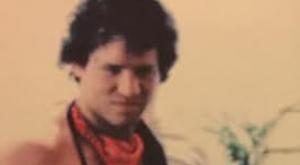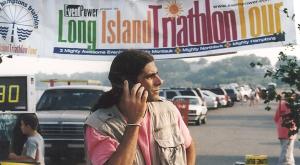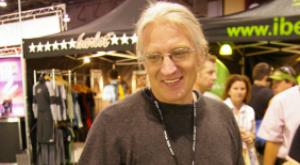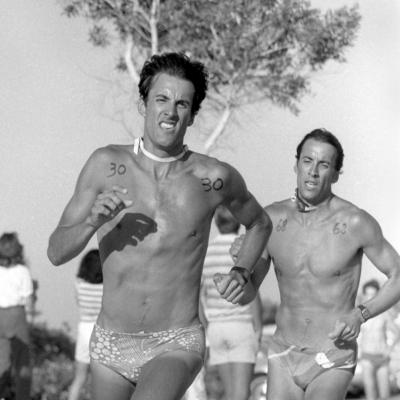
Wally (left) and Wayne Buckingham were among the top club runners in the San Diego in the late 70's and 1980's. They embraced multisport competition eagerly and were regulars among the leaders David Pain's Birthday Biathlon -- Moment #1 on Scott's Top-40 list.
I must admit, I chuckled when I read my partner and co-founder Scott’s list of 40 big moments. What the hell else had I expected? White toast and tea? I fully expect many of Scott’s decidedly esoteric choices will be controversial. Heck , even I don’t agree with many of them, and our literary/journalistic partnership goes back more than three decades. But isn’t that what lists are for, really? They put a stake in the ground and challenge folks to expand the game, enlarge the boundaries, generate circular discussions and never-ending disagreements. As Scott himself writes, “…it’s the discussion that matters more than any one person’s rhetoric.”
If Scott’s list makes you all warm and fuzzy, pass it along. Tell people that it’s a great piece and they have to read it. If it pisses you off, share it even more broadly. Tell people what jerks we are and how they should all write in with their own lists. Maybe in six months we’ll publish the 200 Greatest Moments in Triathlon History, as compiled by the readers of TriHistory.com. Ya never know. For now, enjoy. -- MP
Two score and a couple weeks past or before today, triathlon will be (or just turned) forty year old. No cake, no bang-bang noise in the sky, barely a mention on some obscure blog site. Humble beginnings on a dustily-reclaimed spit of land in a boggy back bay somewhere north of Mexico; a place that Portuguese explorer, Juan Rodriquez Cabrillo mistook for the entrance to San Diego Bay in 1542 and named it False Bay. Forty six endurance oddities, plus or minus one couple who swore they were there and were later re-inserted into the two unclaimed slots, completed the event. No one remembers how many started that Wednesday night on September 25, 1974. And no one really cares.
Nothing false about letting history simmer, that quiet low heat of time.
Less than eight years after that event of 9/25/74, Julie Moss would crawl her way into ABC TV hearts and minds. Twenty four years later, triathlon would be exposed to the world during the Sydney Olympic Games. And over thirty years post, professional triathletes would earn six figures for less than two hours of racing. But those pugmarks in the sport’s history are still driven by media and myth. Take away the tale and the tube and there dissolved is Moss’ red hair, that brassy Olympic gold, and quickly-earned greenbacks. Without the spin, Technicolor dreamscapes are faded to black.
Signal that the dark gritty back story matters now more than ever.
For a variety of reasons, that very first planned, documented, and sustained swim/bike/run sporting event run on Fiesta Island never made the evening news. The only thing it made was the suggestion of possibility.
Well, that was a hell of lot of fun, the competitors muse. When’s the next…what do you call this thing? Tricathalon?
Wow. I feel pretty good. Not as beat up as after a marathon. Pass me another beer.
######
I was two years too late to that first party, arriving San Diego’s Mission Beach in a ’65 VW Bug and a college pair of cut-offs. It was 1976 and the sport of triathlon had doubled in size in just two years. In an effort to meet pent up demand, renegade organizers from the San Diego Track Club offered not one but two triathlons that bicentennial summer. Entry fees closed in on the eight dollar level. Our two lost competitors from September 1974, John and Judy Collins, now officially and respectively placed at 30th and 35th, took the swim/bike/run concept to Oahu when Collins, a Navy Commander, was re-stationed in Hawaii. By February of 1978, Collin’s Iron Man was forged on the backs of more myth and more media. Just another $100 million brand born quite by accident.
That first 9/25/74 event went away from the sport’s collective memory for several decades, only exhumed at the request of some quirky grad students studying postmodern sport history and a handful of nostalgic silverbacks with a penchant for documenting the 2nd third of their sporting lives.
But then something happened on the way to fame, fortune, and respectability. Triathlon was noticed. Blame it on the triumvirate of media, money, and something intangible and unexplainable. Blame it on accident.
And just where the hell did this sport come from? They asked? Who were Shanahan, Johnstone, Phillips, and Warren? A law firm specializing in spandex lawsuits or the race organizers and one time fittest triathletes on the planet? What about this other guy situated at the root in some genealogy of a multisport tree? David Pain, you say? Pain? Perfect. Was he the guy whose annual swim/run birthday bash was the partial impetus for the Don Shanahan/ Jack Johnstone team that dreamt, created, and ultimately walked away from the reality that they had frickin-founded the sport? Is Dave still alive? And Phillips? Still a professor of exercise physiology?
Phillips had won that first event at 443 years young. A story too good to be true. But it was.
What about Tom Warren, Tom Boughey, the Buckingham twins, Wally and Wayne, Mack Larsen, Bill Gookin, Sue Krehn; all names that nailed podiums as they figured in historical crosses…arguably the fittest athletes on the planet living in absolute obscurity.
Then and now.
I remember being at one of the events in 1977 or perhaps 1978. Things were getting competitive by then and I’d borrowed a ten speed racing bike from a guy who had an uncle who had been to Europe. Or at least knew another guy who had. That’s where you found the exotics. The chain on my beach cruiser had broken while I was doing PB Tavern repeats and I took it as a sign. Get the good shit and go out and win one of these.
I was feeling pretty confident on this particular Wednesday night event and as I lowered my kick stand, out of the corner of my eye I spied a convoy of grey pickup trucks. Laden with Navy SEALs, rolling onto the Island, WTF? SEALs in Mission Bay? It was as if LAPD SWAT teams had descended on Disneyland to bust some kid who cut the line. Word had gone out that this underground cult sport was the best organic proving ground of fitness and perseverance. The competition was soft--they had heard-- a bunch of lifeguards, college surfers, old guy docs, and one barkeep. The SEALs came roaring in on those land ships with Navy bikes and Navy boots and Navy SEAL attitudes. But they left with barely a top ten finish, schooled by the developing nuances of this emerging sport and a group of rag-tag beach bums who just happened to be very decent at more than one thing.
It was good to see the derelicts rule the world.
######
When I wrote the first history of triathlon book in 1995 the text opens up with this line: “I don’t care who started the sport of triathlon. And you shouldn’t either.”
I’d like to re-qualify that claim. I now care more than ever about the claims of origin. There is more at stake than ever. If Sutter and his pals would’ve protected their squatter’s rights and discovery of gold in California they would not have died young and broken and forgotten. An authentic history matters because generations after it will have been subject to the mediation of time. And less-caring voices.
So, for all those who still think the sport of triathlon began in the 1904 St. Louis, USA Olympics when one “Mr. Emerich” won an event consisting of a long jump, a shot put, and a 100 yard dash or you choose the Continental version based on here say of one Charles Sector, a claimed competitor in a bike/run/swim event run off the coast of Marseilles, France on September 4, 1921, I believe you. In the past two hundred years, however, there must’ve been any number of sporting events that consisted of three events and I imagine that a handful included swimming, cycling, and running. But how many were advertised, recorded, documented, and sustained? How many are still firmly situated in the legal, the legacy, and the lore? How many, when placed under the white hot spotlight of support-your-claimisms, have survived unscathed and intact?
I’m going to put my money on 9/25/74 and let it ride.
######
So, upon that rock and in concert with the forty year roll of time, I offer these top 40 moments that shaped, informed, built, busted, defined, and directed the sport. As with any list, the choices, both personal and professional, experienced and expropriated, are necessarily political; we identify with that which informed us, which made us. The list below is but one person’s attempt to rectify the always interpretable question: What were the key events, the people, places, and things that shaped a sport’s history? And for this writer, and what is left of this athlete, it’s the discussion that matters more than any one person’s rhetoric. As my neighbor, Jackson sings, “you gotta bring your own redemption when you come.”
- Root Pain. On July 31st, 1972, San Diego attorney, Dave Pain decides to celebrate his 50th birthday when he conceives and then organizes a run/swim affair near his home in San Diego’s south Mission Beach. It follows the boardwalk and calm waters of Mission Bay; a 4.5 mile run and approximately 300 yards of swimming advertised as ¼ mile. Pain recalled in 1993 that, “My birthday biathlon was an entity unto itself.” But in the service of historical documentation, perhaps much more.
- Welcoming the Draft. SDSU Exercise physiologist, Dr. Tony Sucec crosses Pain’s finish line (his porch where the draft keg beer is being chilled) first, and steps into history as the first de facto victor of a small, underground, multisport cult event. Pain reminds us that he had “50 or 75 people the first year Tony won and there was no entry fee…and from time to time I’d get calls from running magazines who wanted to make it into a much bigger event. But I wasn’t interested.”
- The First. Spring 1974, San Diego Track Club members, Jack Johnstone and Don Shanahan separately, then collectively, consider staging a late summer event that was less about running and more about…well, they weren’t really sure. Each gets wind of the other’s intentions and they join forces. Let’s do it in the fall, they decide, when the traffic is less and the water still warm. Bingo, the first real triathlon happens on 9/25/74. Interestingly, the same day as triathlon journalist extraordinaire, Mike Plant’s birthday, and the 2nd anniversary of my young father’s death.
- The Challenge. January, 1977, Cdr. John Collins proposes the question of “who is the fittest of them all” at the Awards Ceremony for the Oahu Perimeter Relay Running Race. It was at the Primo Gardens, according to Cdr. Collins. And yes, Primo is a brand of beer. The three distance events on Oahu (Waikiki Rough Water Swim, Round the Island Bike Race, and the Honolulu Marathon) constitute part of Collins’ suggestion. And though only Collins remembers what he said or didn’t say to catalyze what would become the Ironman Triathlon, something significant happened with Collins, that time, and that place, and what became of those who took up his challenge. Collins story is surrendered into myth and thus only the muse can affect reality.
- Ironmania. Around 1978 or 1979, after Ironman founder and original race director, John Collins chose not to pursue a career as a producer of endurance events, the Ironman ended up in the lap of Nautilus Fitness Center owner, Hank Grundman, a gracious gentleman who had extended his club’s facilities to many of the 1978 and 1979 Ironman competitors. His then wife, Valerie Silk, would end up with the uh…property, in an eventual divorce settlement and would go on to nurture the IM until her sale of it to Dr. Jim Gills, a Florida ophthalmologist in 1989. Silk, to this sport’s great misfortune, is likely the most under- heralded persona, the victim of branding law, neglect, and her own hyper- empathetic being. Valerie Silk just got beat up by bigtime sports.
- The Pen. Barry McDermott pens his famous May 4, 1979 article in Sports Illustrated. 6500ish words of pure bitchin prose. Somebody at ABC Wide World of Sports reads it and sends a memo down the hall. “Get a damn crew out to this crazy ass sport next year!” TV comes to Oahu in 1980 and UC Davis grad, Dave Scott wins going away in a par of tube socks and a back-up bike laden Chevy wagon following in support. His margin of victory is similar to running a first time marathon in 2:08. But cottage cheese and OCD will challenge what might’ve been (and maybe is) the greatest triathlete of all time. If you add his skills in playing piano, his never-ending good looks, and his parish priest sensibilities, the Man in unequaled. But McDermott never wrote about Big Dave. For that writer, Warren was always the Original Ironman.
- The Cost of a Cult. The Horney Toad Triathlon is run in the summer of 1981 with the first “partial Ironman distance” of 1.5 mile swim, 50ish mile bike, and 13 mile run. Seventy five athletes start and seventy five finish. Los Angeles County Lifeguard, Mark Montgomery wins. The following year in early June 1982, Horney Toad offers $4000 in prize money, unofficially becoming the first prize money triathlon in the world. It is also the first event ever sanctioning by the new US governing body, the U.S. Triathlon Association. Within two years, it was sucked into some black hole of memory. Horney what?
- The Crawl. February 1982. The Year of Moss and McCartney. ‘Nuff said.
- The Meeting. In the spring of 1982, a meeting was held at the restaurant, Gladstone’s for Fish in Malibu, CA on Sunday afternoon after the Los Angeles stop of the USTS. The intent was to start a national governing body for the sport. Or at least to agree on a handful of things like how long the distance might be. And that was the birthplace of USAT. Carl Thomas is there, Jim Curl, Sally Edwards, Dave Scott, ST, Rick Delanty, Harald Johnson, hell…it’s a who’s who of a nobody sport.
- The Logo. San Clemente artist, athlete, and high school art teacher, Rick Delanty, is paid $50 to design the first US Triathlon Association logo. The stick-figurish swimmer, biker, runner is subsequently ripped off by five thousand races over the next decade before Delanty is finally discovered in the late 90s, as a sought-after plein art painter. By some reports, the original check had bounced. It’s triathlon’s version of the Nike swoosh.
- The Standard. In the summer of 1982, the United States Triathlon Series was launched in a five city tour (San Diego, Los Angeles, San Francisco, Portland, and Seattle). Distances were 2k swim, 35k bike, and 15k run. Prize money was $500 for first, $300 for 2nd, $200 for 3rd, equal for men and women. Scott Molina won a few of those races and credits a handful of $500 checks in the summer of 1982 for changing his life. But he leaves one on the table by refusing to wear a required helmet. His hair then and now, is perfect.
- Woman Power. Sally Edwards, a participant in that first pre-USAT meeting and owner of Fleet Feet Sports, pens the first book on triathlon. It seems sophomoric now but for the seething masses wanting but a morsel of knowledge, it becomes for a period, the go-to resource. Edwards, for her part, will find sustained success in many aspects of race production, marketing, and ambassadorship. Her vast contributions remain under-appreciated.
- Just Nice. November of 1982. Nice Triathlon, first ever in Europe (we think). I had worked with IMG to set up a radically-cool Tri-Country Triathlon where we would swim off of a boat into Monaco, ride south into Italy, and then run back into France. Live international TV coverage for the top 100 athletes in the world. But then Monaco’s Princess Grace died in a car crash on the Corniche September 13, 1982. The country was in mourning and banned all sports and cultural events for 90 days. The event was moved 30k up the road to Nice, France but most of the best were still there and Mark Allen won the first of his 10 Nice Triathlon victories.
- The Bilking. The investment firm, JDavid, starts a triathlon team and invests many thousands in sponsorship of budding pros. Everybody but Dave Scott, it seems, drinks from the falsely-constituted fountain of this Ponzi scheme. Jerry Dominelli and his partner, Nancy Hoover are indicted and each spend time in the Big House for bilking investors of well over $100,000,000. Bad Jerry. Bad Nancy. Bad choices.
- IM Goes Almost Hollywood. In the fall of 1983, Valerie Silk allows a staging of a “franchise” in the first non-Hawaii Ironman event in Los Angeles, California. Thousands were spent, roads closed, an entire television show was produced and packaged but never aired. Scott Molina won in spectacular LA Fashion but for reasons that only reason know, the event was canned, the show locked away in some non-descript warehouse in the San Fernando Valley. But Ironman had tasted the fruits of globalization and everything on-island would never feel the same again.
- The Mags. May, 1983 Tri-Athlete Magazine is produced by UC Berkeley political science grad, William R. Katovsky. Bill borrows $16,000 from his family and friends to launch the first piece of triathlon print and becomes an instant media magnate. Two months later, Triathlon Magazine, based out of Santa Monica, CA will become the first glossy print mag. Its title is Swim Bike Run and the great majority of content are race entry forms. But it’s sexier than the newsprint, Nor Cal Katovsky gig. Mike Gilmore, Harald Johnson, and Penny Little will build this publication into a perennial powerhouse of the sport.
- Wave Off. USTS Co-founders, Jim Curl and Carl Thomas, invent the wave start in an effort to eliminate “the Cuisinart start.” April 28th, 1984 in Tampa Bay, Florida, the USTS stages a kind of rolling start that saves hundreds from certain death by foot-in-face drowning.
- Age Grouped. Ironman 1984. A forty year-old from the U.S. by way of Germany, Klaus Barth, comes in 4th overall. Barth’s family-first, training whenever philosophy signals the idea that nice guys can be champions all day long. Klaus eventually will die of brain cancer and many parts of his home town, Long Beach will be closed during his funeral. Barth, a 30 year vet of the Long Beach School system as coach and teacher, is one of only a few LA athletes whose passing catalyzes a gang war cease fire.
- Globalization. In the winter of 1984, Dutch Wonder Boy, Rob Barel comes to North San Diego to train with the best athletes in the sport. He improves dramatically and becomes the first European to threaten the Republic of Encinitas’ hold on the sport.
- Tugging It. The famously infamous Tug’s Tavern Swim/Run/Swim, a progenitor of all multisport events since the earth was cooling, holds its final event in August of 1985. I shave, taper, and psych myself into the last victor’s position and then spend two days in his pub celebrating.
- Money for Nothing. Ironman 1986. First year of prize money. Race Director, Valerie Silk had resisted “professionalizing” the event by offering prize money but found it hard to resist when Steve Drogin, a wonderfully altruistic financier from La Jolla, CA and part time Kona resident, offered to anonymously put up $100,000 for a prize purse with no strings. Steve passed a few years ago and was never publicly thanked for his gift to the world of triathlon. A black mark on the sport for sure. Thanks, Stevo.
- Adult Floaties.Triathlon swimming wetsuits, while under prototype (hyperlink to my wetsuit piece) in 1982 and used by Aussie triathletes in 1983, come fully to market with Dan Empfield’s Quintana Roo design and production in 1987. The debate about advantages of neoprene rages for years with little final conclusion.
- Aero This! Richard Bryne (Speedplay Pedals), designs a platform handlebar system for a friend, Jim Elliot, who is competing in the 1984 RAAM (Race Across America) in an effort to reduce neck fatigue and facilitate food consumption. The rider notices the accidental aerodynamic advantage. Two years later, Boone Lennon of Scott USA develops, produces, and markets a downhill skier-influenced handlebar design. Brad Kearns and Andrew McNaughton become the first multisport athletes to use the bars at the Desert Princess Duathlon in 1987. The physical therapy industry holds a party. Their future in lower back attention is secure for a generation.
- Doing the Du. Duathlon is born in 1986. For a period, popularity increases. Seems there are lots of people who love multisport but are just fucking scared of the water. West Covina native, Kenny Souza is preternatural king for 36 months. He races in tiny thongs and grows his hair long. Bon Jovi in a water bottle. But then people get used to the water and the sport fades to black.
- A New King is Born. On April 23rd 1988, Alastair Brownlee is born. Or was if his bro, Jonathon. They are both wickedly fast from birth. Good sperm. Better eggs.
- Skid is Scuttled. Scott “Skid” Molina wins the 1988 Ironman in Kona but there is some discussion of disqualification when he is accused of doping at the earlier Nice Triathlon. I had raced at that Nice event and was amazed when our urine samples were sealed by Glad Wrap and a rubber band. The accusing group is a renegade sampling of non-US based bureaucrats intent on creating an international governing body. Molina, after months of defense by his friend and agent, Charlie Graves, is waived of all charges.
- Ironed. 1989, Dr. Jim Gills, a Florida-based ophthalmologist, purchases the Ironman from Valerie Silk for a reported $2.8 million. Silk, who had nurtured the event as a child, gradually steeling herself to the vagaries of high level sport management, would give half to a partner, another chunk to taxes, and then a subsequent settlement of a sale-based disclosure lawsuit. After suckling the event for over ten years, Silk, that largely forgotten figure, will retire to a small condo in Florida to care for her aging parents.
- First Worlds. The first ITU World Championship is held in Avignon, France. Mark Allen wins convincingly and ITU as the world governing body is now on the map. The politics of the sport get curiouser and curiouser.
- Deeked! Jimmy Riccitello, the most skilled cyclist in that period and a man of high integrity is disqualified for a “position foul” on the bike at the 1989 Hilton Head USTS National Championships. He loses $27,500 for the highly disputed and contested call. Suddenly, TriFed draft marshals have the ability to change lives.
- Another One? On April 30, 1990, Jonathon Brownlee is born. Good egg. Better sperm.
- Lil Aussie Battler Begins. The 2nd ITU World Championship is staged at Disneyworld, Florida by the USTS team of Carl Thomas and Jim Curl with partnership from Massachusetts –based race director, Dave McGillivray. Aussie upstart, Greg Welch wins and hangs out with a Minnie Mouse mascot at the finish line. ITU President, Les McDonald beams. His IGB-ITU is OTW is (on the way) to IOC inclusion and LTD (living the dream) status.
- Duing it Big. Duathlon makes a play at respectability when a long distance Du is staged in Zofingen, Switzerland. Many of the top triathletes attend in search of the fat prize purse. Kenny Souza remains one of the top duathletes. Swiss cows and mild chocolate all around.
- Legal Wheel Sucking. Draft legal races are the most contested topic in the sport since equability of distances. Many of the old pros feel that drafting is a direct violation of the “spirit and intent upon which this sport was founded.” Pro-draft politicians argue for the way drafting makes for “good TV.”
- Singing for the Union. In an effort to establish autonomy and have a chip in the game of high level sport, US-based efforts to organize professional triathletes make some headway. But their agency is cut short when TriFed must promise the USOC that there are no other competing groups representing the sport in the USA. This is done and agreed to by the fledgling pro group in an effort to show USOC and the IOC there is solidarity in this sport. All is done because Olympic inclusion is the Grand Prize.
- Goin’ to the “lympics”. The Sydney Olympic Games go on. Draft legal. The world is amazed at these athletes. No one really knows if the ends justify the means. After Sydney the sport is bigger and maybe/maybe not better. The first wave of triathletes shake their heads and go back to their lives. The second wave hopes there is a business opportunity. They share excel spread sheets of how to change your life through tri-training.
- Mind on the Money. Triathlon becomes profitable for some, but not that many people. It will be decades before a trade association is created to facilitate growth of the commercial side of the sport. The Old Guard and the California Mafia are split. You are either in it for money or you’re not. Friendships are destroyed. No one wants to speak of the obscene underbelly of the sport. Secrets buried for life.
- Flame Out. 1993, USTS goes down. Most of the ’93 scheduled events are staged though a few are noticeably downscaled. Chicago’s event is moved from the Great Lake Michigan to a man-made “corporate lake.” But support is still high from the Everyman and a strong majority of the pros who had come to rely on the Coke Grand Prix prize purse for rent and groceries. To the dismay of many, that $100,000 purse wasn’t there to be paid at the end of the season and Co-Founder, Jim Curl would spend the next 18 months working to pay what was reported as “almost 70 cents on the dollar” to the pros. It was a gallant effort on Curl’s part.
- Hell on Wheels. 1997, Thomas Hellriegel wins the Hawaii Ironman. He signals the true arrival of Euro-talent and opens the Kona floodgates for thousands of German tourists clad in skimpy spandex, tanks tops, and Jesus sandals. The following year, the Underpants run is established as a tongue-in-butt-cheek response to this oddly offensive style.
- Only Body Parts. Same day, Oct. 18, 1997. Jim MacLaren becomes the first physically challenged athlete to finish Ironman under able-bodied cut off times. He is constituted as the first cross over able/PC athlete in the world to transcend all notions of possibility and emerges as the face of the rapidly expanding Challenged Athlete Foundation. He is handsome and thoughtful to a fault. His speeches are enrapturing. And he will die of complications from his life’s pathos on August 31st, 2010. He was 47. And missed.
- Mo Money. On June 17, 2007, The Hy-Vee Triathlon sponsored by Iowa-based grocer, Hy-Vee, offers $200,000 each for the top male and female finisher in this Olympic distance event. With nearly a million dollars in prize money, two athletes will arguably earn more than every triathlete in the first 20 years of the sport. They will become sought after personal coaches offering excel spread sheets en masse.
- Honorable Mention
Dog Hairs: Scott Molina, after being inducted into the USAT Hall of Fame on a Friday night in June of 2012, enters the first ITU event ever held on US soil on Sunday morning. He will finish 3rd in his age group on a borrowed bike, wearing 30 year old spandex and a 20 year old attitude. To celebrate, he walks one-half block to the ocean front, buys a beer, and sits on the seawall looking out over the great blue Pacific Ocean towards his adopted home of New Zealand, 8500 miles to the WSW. A cop will write him a $350 ticket for “open container” as he ponders why he ever bothered to come home.

